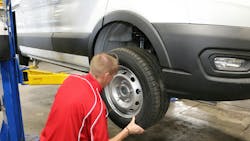Retail sellout trends in January were slightly negative following positive sellout trends in the month of December. On average, dealers saw retail unit sales fall 0.4% year-over-year in January following a 1.1% gain in December.
Regionally, the Northwest saw the strongest trends, up double digits compared to a year ago. That growth was driven by weather, and specifically, heavy snowfall. That said, the Midwest, Northeast, Southeast and Southwest regions all saw volumes on the negative side of the ledger in January. The Southeast saw the softest trends, with volume down 6.3% in the month.
Seven percent of our dealer contacts reported negative demand in January, a sequential improvement from the 25% of our contacts who saw negative demand in January 2023. Those who experienced heavy snowfall reported a sharp increase in demand during the month.
Apart from weather-driven trends, tire dealers report sellout levels continue to be affected by elevated tire prices and the macro environment, which includes a lack of rebate offers from tire manufacturers. It appears the consumer trade down and deferment cycles continue to hang over the retail tire industry.
We have long hypothesized that an acceleration of winter weather could spark a “catch-up period,” we’ve now begun to lap the one-year mark of soft sellout trends — with few signs of positive momentum, except for what was recorded in the Northwest. From our view, the tire market remains in neutral to start 2024.
The miles driven data continues to point in the right direction. Trends were positive in January for the third consecutive month. We note our miles driven momentum index registered a 1.7% year-over-year increase in January, following a 1.8% increase in December. While positive, we note the January 2023 comparison period was particularly soft. Early data shows February continuing the positive miles driven trend.
While volume and demand trends are likely less than hoped for at this point in the year, we believe underlying fundamentals for tire replacement and the broader aftermarket show a healthier backdrop compared to this period a year ago.
The pricing question
The combined raw material costs to build a replacement tire fell an average 0.5% in January, following a 3.3% year-over-year decline in the fourth quarter of 2023. Collectively, last year our tire raw material index fell 9.6% from 2022. Following a year of cooling inflationary prices — every month of 2023 registered a year-over-year decline — we now see aggregate raw material prices only slightly below levels from a year ago.
While we’ve wondered if some incremental price concession could be on the horizon in 2024 given the stability of raw material prices, we look at Goodyear Tire & Rubber Co.’s recent earnings report from the fourth quarter of 2023. The company recorded the greatest price/mix from raw material benefit in over a decade. As a result, we expect manufacturers will try to hold onto price as long as possible.
That said, we continue to believe there may be a level of price decreases at some point in 2024 as raw material costs stabilize and inventory levels appear to be more normalized. Manufacturers may concede some price to encourage tire wholesalers to begin taking on more inventory.
Tier-one prices ‘too high’
Dealers indicate tier-two tire brands were the most in demand from consumers for a second straight month. Dealers continue to mention they’re seeing the effects of consumers trading down, and several independent tire dealers noted the elevated price point of tier-one tires is “simply too high for most consumers.”
We note tier-two brands being the most in demand matches the historical trend we’ve seen in the 10-plus years of our monthly tire surveys. In January, tier-one brands were the least in demand, marking a fifth straight month of these brands placing last in our survey. This is the first such occurrence of tier-one in the bottom of the rankings for five or more consecutive months since August 2020-April 2021. During the pandemic, tier-one tires were in last place for nine straight months. We remain of the view that longer term, consumers will opt for tier-two tires as they look for a balance of price and performance.
We continue to believe the North American pricing environment will remain in line with raw material costs. We expect tier-one and tier-two producers to continue to be disciplined in managing the trade off between price and volumes to maximize operating profit rather than market share.





